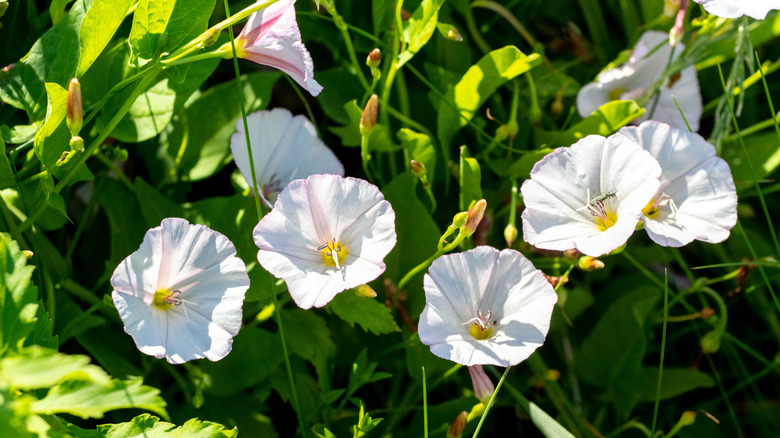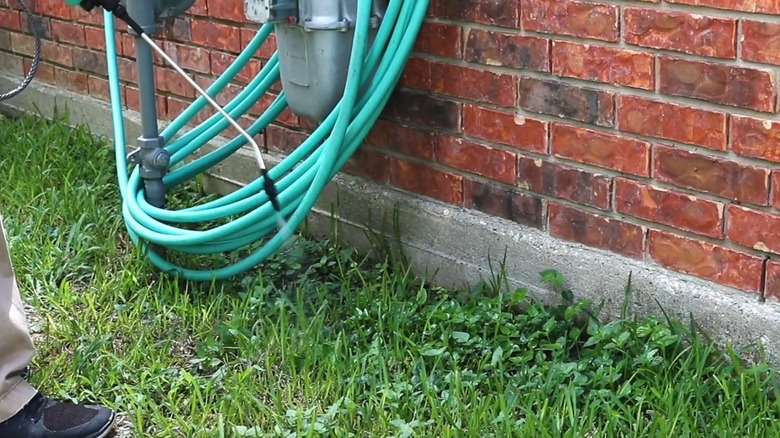Mistakes Everyone Makes When Trying To Get Rid Of Pesky Bindweed
Having arrived on the East Coast as a seed contaminant in the 1700s, field bindweed (Convolvulus arvensis) has since spread west and been labeled invasive or noxious in 35 states. Granted, it produces dainty flowers, which might convince some gardeners to leave the weed alone. However, this is a big mistake, as its fast growth and aggressive nature empower it to take over the area, decimating the yard or landscape. Sharing his thoughts about bindweed in an exclusive interview with House Digest, Bryan Clayton, CEO of GreenPal, admitted, "It's a real pain because it spreads fast, chokes out your plants, and the roots run deep."
Field bindweed sprouts a taproot that can penetrate the soil 20 feet deep. This taproot further develops lateral roots which, despite colonizing only the top 2 inches of the soil, can spread over an area up to 18 feet across. Worse yet, being fragile, these roots break up easily when you pull the weed from the ground. Given this tendency, Clayton advised against superficial weeding. "One of the biggest mistakes folks make is just yanking it out real quick without getting the root. If you don't pull at least 2 [to] 3 inches of the root, it'll be back in a week," said Clayton. He also raised concerns about weeding in the wrong conditions, lacking persistency, and using herbicides incorrectly when getting rid of bindweed.
Don't make the mistake of spading in dry soil
All weed management practices dictate that you should avoid pulling weeds from dry soil, and bindweed isn't any different. That's because when the soil is moist (not soggy or wet), pulling out the roots becomes easier and lowers the risk of snapping. "You've [got to] wait until the ground's a little damp — after a rain or light watering — and use a hand spade to loosen the soil and dig it out [slowly]," explained Clayton in his exclusive interview with House Digest.
Ideally, you'd carry out this task in early spring, when the soil is already moist, the weeds are in their seedlings stage, and their roots haven't spread out far and wide. But if you've missed the window of opportunity, remove the weeds before they flower and set seeds. Otherwise, achieving eradication will be nearly impossible, as the seeds can stay viable for decades.
Another mistake to avoid is not weeding frequently. "Most folks also give up too soon. You've [got to] be consistent. One and done doesn't work with bindweed," said Clayton. Essentially, when you hand-pull weeds weekly, you subject their roots to 'carbohydrate starvation.' Since seedlings replenish the roots' energy store as they mature, constant pulling diminishes the roots' reserves, killing the plant. However, for a mature patch, you must keep at it for three years or more to achieve complete eradication.
Take ample care when using chemical herbicides
Understandably, few gardeners have the time or will to constantly pull weeds from their garden by hand. Many would rather switch to chemicals to eliminate the infestation — a sentiment our expert shares, too. In his exclusive conversation with House Digest, Clayton maintained, "... honestly, your best bet is a selective herbicide made for bindweed. That's what we used on customer lawns."
Crucially, don't apply herbicide when rain is in the forecast. "Apply it in the early morning when it's calm, and make sure you've got 24 hours of dry weather ahead — rain will wash it right off and waste your time," Clayton said. To limit damage to your ornamentals, place the bindweed vines on newspaper before brushing them with chemicals. Upon drying, remove the paper. If spraying, cover your ornamentals with cardboard for the duration of the procedure.
Another mistake to steer clear of is not repeating applications. Since these herbicides have little residual value, you must repeat the procedure to control new seedlings. "Stay after it for a few weeks, and you'll win. Just don't let it creep all season, or it'll take over the whole yard," added Clayton. Supplement your efforts with mulch or easy-to-grow ground covers that smother weeds.


